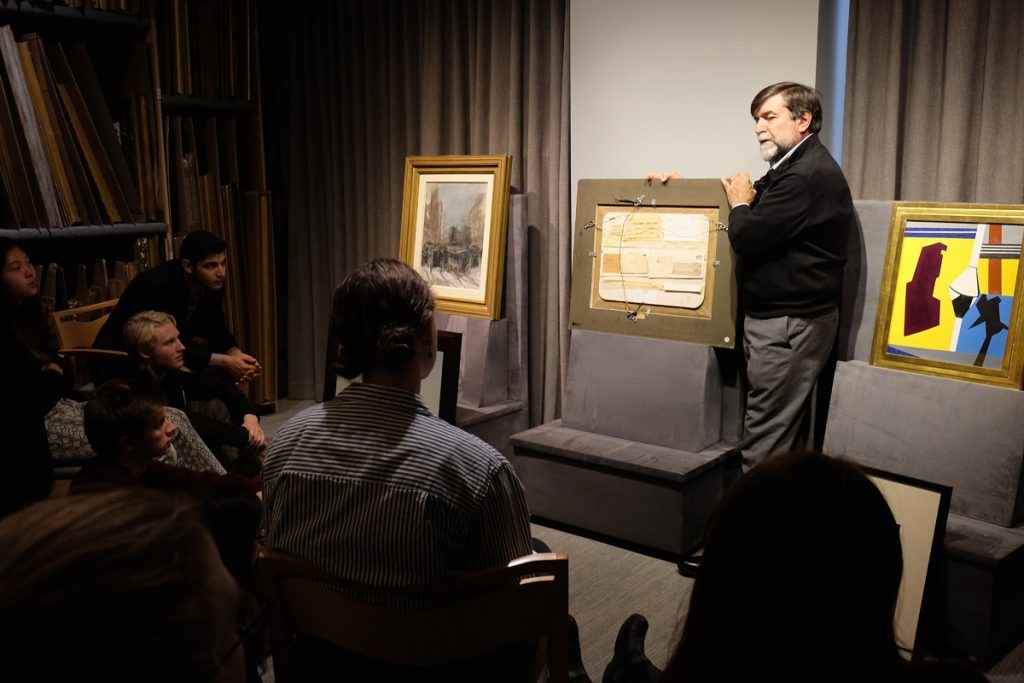Eric Baumgartner, Director, Hirschl & Adler Gallery
By Mary Bei Prince ’20
The field trip to New York City broadened my understanding of economic careers within the art field. Our interview with Eric Baumgartner, during our visit to Hirschl and Adler on Saturday, elucidated the complexities of interpersonal relationships, with the artwork itself as well as the consumers, in selling works of art. My initial concept of galleries as an economically motivated center of liaisons prompted me to question the intentions of art dealers, as I likened galleries to smaller-scale auction houses. However, my experience at Hirschl and Adler positioned galleries within a grey area: while they promoted close handling and visual analysis of pieces and contextualized pieces within their historical framework, they ultimately functioned as a broker between buyer and seller, often relegating art to a more personal and private use rather than allowing for public digestion.

Norman S. Hirschl and Abraham M. Adler founded Hirschl and Adler in 1952. The firm focused on collecting American and European paintings, drawings, and sculptures from the eighteenth through the early twentieth centuries; American prints of all periods; and American decorative arts from 1810 to 1910. The staff members curate special exhibitions that investigate both historical and contemporary themes or showcase the work of individual artists. The pale pink walls within the Fuller Building space were inhabited by large canvases by Louisa Chase (American, 1951-2016). Chase’s art decorated two of the three rooms, while a smaller enclave housed older pieces – like a watercolor by Winslow Homer (American, 1836-1910). The gallery space was intimate and welcoming. I was surprised by the size of the older works occupying the offices as they dominated their respective spaces, juxtaposing the more contemporary office furniture. The viewing room was quite cluttered with paintings, yet it served as a cabinet of curiosity.
My notion of art dealers as knowledgeable yet money-focused was challenged by Baumgartner, as he presented the importance of thoughtfulness when dealing artwork. Baumgartner is exceptionally educated both academically and experientially. He is well versed in the art history related to pieces within the collection – even cross-examining the class on which period or ‘ism’ a piece belonged to. An adept dealer like Baumgartner may wield this sort of scholarship to impact the market, tailoring details to frame the clients’ interaction with the work. Likewise, his careful consideration of the matting and framing of pieces – selecting historically compatible frames and reducing the matting of watercolors – demonstrates his sense of scale and taste. While Baumgartner utilized his command over the subject matter with the intention of closing a sale, he also demonstrated respect for the artwork’s history and condition.
Additionally, this encounter explicated the importance of forging relationships. Baumgartner equated Hirschl and Adler to a sort of ‘service industry’ that sought long-term relationships. This small-scale amenity provided personalized help to collectors and curators with the goal of fostering reciprocal connection. Thus, a gallery, like Hirschl and Adler, acted as a broker between buyers and sellers. My insight into the dealership world informed me of the web of interrelationships between museums, auction houses, galleries, and private collectors. Within my initial conception of galleries, I viewed the work as a series of self-driven interactions, underestimating the gallerists’ attention to cultivating a wide range of personal relationships.
During the visit to Hirschl and Adler, I thought about the subjective nature of value assigned to pieces, and how some artwork amasses widespread efficacy while others generate personal significance. The gallery has the ability to accommodate both realms. Selling a piece to a museum could foster enlightenment of a specific curatorial theme to museumgoers; likewise, the work of art may remain stagnant within the bowels of the permanent collection. And while the sale of an artwork to a private collector ensures a certain appreciation for the work, it also limits the ability of the artifact to contextualize the past to a larger audience. Ultimately, I learned that each transaction is underlined by an appreciation for the piece: its history, its visual elements, and its ability to add value to whichever environment selects it.